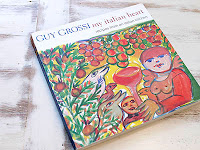From My Italian Heart:
Recipes from an Italian kitchen, Guy Grossi, Lantern, 2005.
To make this recipe you need to begin with a pizza dough.
The one in this book is a very simple one to make. Into the KitchenAid went 10g
of dried yeast. I then added a cup of just warm water, a pinch of salt and
about a tablespoon of olive oil. The mixer, fitted with a dough hook, was
started on the lowest speed. When the yeast was dissolved it was time to add
the flour.
I used a good 00 flour, two cups’ worth. It seemed an easy
recipe to remember: one cup of water to two cups of flour. This was now churned
for about a quarter of an hour until the dough was well formed. I placed a tea
towel over the bowl and left it to rise for an hour.
 It rose really well. I took out a 30cm pizza tray, oiled it
and pressed the dough in until it covered the base. Black grapes were now
pressed into the surface, it was given a sprinkling of salt and olive oil was
dribbled over. It now went into a 180ºC oven for 20 minutes when it seemed to
be done.
It rose really well. I took out a 30cm pizza tray, oiled it
and pressed the dough in until it covered the base. Black grapes were now
pressed into the surface, it was given a sprinkling of salt and olive oil was
dribbled over. It now went into a 180ºC oven for 20 minutes when it seemed to
be done.
I really enjoyed this. It was like eating a fresh focaccia
bread laced with the occasional pop of sweet grape. Had more than one slice.
Taste: ✔✔✔✔
Ease of
cooking: ✔✔✔✔






























